
In 1949, when General Hieu was a 20- year-old young man attending his first year of college at Aurore University run by the French Jesuits in Shanghai, China, Mao Tze Tung chased Chiang Kai-Sheik out to Taiwan, and the Red Army was about to enter Shanghai. That year, he repatriated with his father on a French Navy destroyer. The image of a vast army, copiously financed by the United States, defeated merely because its high ranking officers were corrupted to the point of even selling weapons to the enemy, forever etched in General Hieuís memory. When he was nominated Special Assistant to the Vice-President Tran Van Huong in charge of Anti-corruption in 1972, he counseled the Vice-President that if the anti-corruption efforts in the Army did not bear fruit, South Vietnam would endure the same fate as Chang Kai-Sheikís government; and Vice-President Huong had relayed that opinion to Ambassador Bunker and even to President Thieu. Furthermore, General Hieu had told Thieu that "Either we correct our faults or the Communists will correct them for us."
A couple of months upon landing at Saigon seaport, Mr. Nguyen Van Huong, General Hieuís father, was assigned the post of Deputy Director of Northern Police and Security. Hieu was faced with three options: one was to pursue his studies at Hanoi University; two was to join the wave of youngsters seeking higher education in the United States; three was to enter the Datlat Military Academy of Inter-arms, which was recently established by General de Lattre de Tassigny et Emperor Bao Dai to provide military leadership to the army. He decided to heed the call of the nation. The result is that Vietnam benefits the award of a brilliant cadet and an outstanding warrior.
A Brilliant Cadet
"Tran Hung Dao's classmates all cherished the Major General because he possessed an even-tempered, loyal, and pleasant character." (Cadet Hoang Xuan Lam, 03/01/1999).
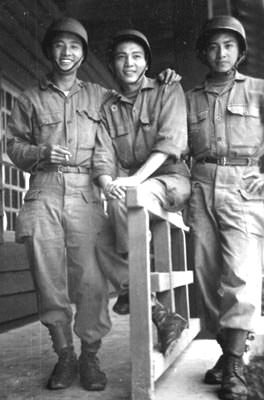
"Hieu was the one I admired the most. He was very earnest; whenever I looked through his window, I saw him at his desk studying and writing. He was very jovial and enjoyable. Whoever met him for the first time would like him immediately. He was very straightforward with his comrades and assumed his responsibilities with perfection. He had the appearance of a professor; Vietnamese and French instructors equally respected and liked him. When he assumed the duty of "Sergeant of the week", with the responsibilities of checking the food's preparation in the kitchen on behalf of the cadets, of distributing letters to the cadets, of accompanying instructors on quarters inspection tours, or of resolving multitude miscellaneous problems, he performed them all with the highest conscientious mind. The Military Academy had molded him into an officer, worthy of that name, both physically and mentally." (Cadet Dinh Van Chung, 02/19/1999).
"Like the other classmates, we all cherished Hieu, because of his friendly and very humble character, although he was a young man with a high level of academic background." (Cadet Nguyen Van Toan, 03/10/1999).
"Hieu did very well academically. In the final exam, there were 80 difficult questions in math. Everybody bit his pencil, except Hieu, who sailed through the mathematic huddles with ease. He also excelled in track and field, especially in sprint meets, 100 meters in less than 12 seconds." (Cadet Lu Lan, 09/26/1999).
"Among cadets, Hieu was rather taciturn, affable and jovial, known never to use foul language and argumentative. All of his actions, even the ordinary ones, had a touch of perfection. I had the impression that beneath his taciturnity, along with his affability and a scholarly appearance lied an unspoken determined and robust soul, turned toward a lofty ideal.
If small actions reveal to a certain degree an individual character, then I still remember a couple among the myriad of Hieu's behaviors during his training period. Frequently, on weekends, there were inspections of quarters, uniforms, equipment, weapons of each cadet. The inspector officer was Captain De Taine, commander of cadets Division. In an inspection, Hieu's pair of boots were used by Captain De Taine as a model of boots polishing. In reality, any cadet's pair of boots were polished thoroughly atop, but if the sole was carefully examined, the majority had traces of dirt around nails' ends. But Hieu's pair of boots was spotless and sparkling upside down!
During the inspection, the commanders of the Academy also paid much attention to cleanliness around living quarters and especially around public bathrooms. When it was Hieu's team's turn to be responsible, I noticed that Hieu volunteered to assume the most tedious job, that of cleaning the cement floor using a massive piece of cloth attached to a T-form stick. First pour water, second sweep and brush, finally dry clean. Before the time of inspection, if somebody came in to wash his hands and spilled water onto the floor, Hieu would wipe clean without a word.
Toward close or casual friends, Hieu equally showed affability and patience. On one weekend, we were allowed to leave our military camp.  Hieu invited me to visit Entreray's tea plantation by motorcycle rented in downtown Dalat. In all honesty, I did not know how to ride a motorcycle; I did try once and fell miserably, but when Hieu invited and promised to teach me how, I was eager to go. And so, we rented each one a Peugeot motorcycle, turned on the engines, and Hieu instructed me how to change gears, turned on the accelerator, etc...and he rode slowly ahead of me, I rode behind him! On our way when we engaged in some elevated roads, I killed the engine quite a few times! Hieu slowed down and signaled to me when to change gear number 2, number 3, and when to change gear back to number 1. It was quite strenuous, but then we made it to our destination and came back sound and safe. During all our trip, Hieu demonstrated joy and patience, never did he express any complaint and impatience because of my clumsiness." (Cadet Quan Minh Giau, 10/23/1999).
Hieu invited me to visit Entreray's tea plantation by motorcycle rented in downtown Dalat. In all honesty, I did not know how to ride a motorcycle; I did try once and fell miserably, but when Hieu invited and promised to teach me how, I was eager to go. And so, we rented each one a Peugeot motorcycle, turned on the engines, and Hieu instructed me how to change gears, turned on the accelerator, etc...and he rode slowly ahead of me, I rode behind him! On our way when we engaged in some elevated roads, I killed the engine quite a few times! Hieu slowed down and signaled to me when to change gear number 2, number 3, and when to change gear back to number 1. It was quite strenuous, but then we made it to our destination and came back sound and safe. During all our trip, Hieu demonstrated joy and patience, never did he express any complaint and impatience because of my clumsiness." (Cadet Quan Minh Giau, 10/23/1999).
Cadet Ton That Dong recounted that Cadet Hieu won the first prize in the high jump and was the most astute in direction calculation and map reading; that was why, in operational exercises, Cadet Hieuís team was always the first to reach the destination.
It is safe to assume that Cadet Hieu won the first prize in fire range exercises because later, Captain Hieu won the championship in pistol shooting competitions organized by the I Corps in the years of 1957-1962.
General Hieu continued to build on the foundation set by the formation period at the Military Academy later in his military career in acquiring both the Vietnamese and American Airborn insignias; furthermore, he learned sky-diving, helicopters, and even A-37 combat jets flying.
An Outstanding Warrior
The Tri-Hieu Tandem
General Do Cao Tri, besides General Tran Van Don, was the one who recognized and made use of General Hieuís exceptional military skills. When Hieu graduated the US Army Command and General Staff in May 1963, General Tri appointed Lieutenant Colonel Hieu to the position of 1st Infantry Division Chief of Staff; then, when he replaced General Le Van Nghiem as I Corps Commander, he made Hieu 1st Division Commander. It was in this capacity that Lieutenant Colonel Hieu led a unit of the 1st Division in assieging Ngo
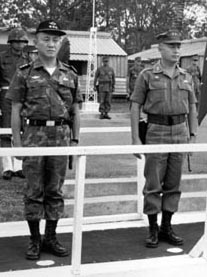 Dinh Canís palace and in meeting with President Ngo Dinh Diemís brother. He succeeded in persuading him to order his palace guards to lay down their weapons without having to fire a shot. After the November 1963 coup, Colonel Hieu was brought to Danang to become his I Corps Chief of Staff; then, he followed General Tri to Pleiku when General Tri and General Khanh swapped their respective I and II Corps to continue to be his II Corps Chief of Staff. On 9/10/1964, General Tri made Colonel Hieu 22nd Division Commander, but then he was relieved of the command of II Corps for being suspected of participating in the military putsch led by General Duong Van Duc that occurred on 9/15/1964. Within five months, on 10/24/1964, Colonel Hieu was put back to his former position of II Corps Chief of Staff by General Nguyen Huu Co, who replaced General Tri as II Corps Commander, until he was assigned back to the position of 22nd Division by General Vinh Loc to replace General Nguyen Thanh Sang on 6/23/1966.
Dinh Canís palace and in meeting with President Ngo Dinh Diemís brother. He succeeded in persuading him to order his palace guards to lay down their weapons without having to fire a shot. After the November 1963 coup, Colonel Hieu was brought to Danang to become his I Corps Chief of Staff; then, he followed General Tri to Pleiku when General Tri and General Khanh swapped their respective I and II Corps to continue to be his II Corps Chief of Staff. On 9/10/1964, General Tri made Colonel Hieu 22nd Division Commander, but then he was relieved of the command of II Corps for being suspected of participating in the military putsch led by General Duong Van Duc that occurred on 9/15/1964. Within five months, on 10/24/1964, Colonel Hieu was put back to his former position of II Corps Chief of Staff by General Nguyen Huu Co, who replaced General Tri as II Corps Commander, until he was assigned back to the position of 22nd Division by General Vinh Loc to replace General Nguyen Thanh Sang on 6/23/1966.
Three years later, on 8/14/1966, General Hieu was called by General Tri, III Corps Commander, to head the 5th Infantry Division. Among the three Commanders of the 5th, 18th and 25th Divisions in III Corps, according to Colonel Nguyen Khuyenís observation, who was at that time III Corps Military Security Chief, General Tri "seemed to make us of General Hieu the most". He relied in particular on General Hieuís military leadership with his 5th Division to bulldoze VC sanctuaries of Duong Minh Chau and Ho Bo, and in so doing, to deny units of South Liberation Front and the South Central Command safe heaven and they were forced to find refuge across the border into the territory of Kampuchea. At the beginning of 1971, President Thieu wanted to appoint General Tri. Field Commander of Operation Lam Son 719 in replacement of General Hoang Xuan Lam in order the rescue its worsening situation, General Tri wanted to have General Hieu replaced him as III Corps Commander, but Thieu did not agree, and when General Tri was suddenly killed in a helicopterís accident on 2//1971, Thieu assigned General Nguyen Van Minh to replace General Tri.
Everybody knew General Tri was a competent general, but only a few, including General Tri, knew General Hieu was also a competent general. To prove this fact, let us review some of General Hieu's military accomplishments.
General Tri entrusted Colonel Hieu, II Corps Chief of Staff, the design and execution of Operation Quyet Thang 202 aiming directly at the impenetrable VC stronghold at Do Xa,
 embedded deeply in the Annamite Mountains, at the junction of three provinces of Kontum, Quang Ngai and Quang Tin, from April 27 to May 27 of 1964.
embedded deeply in the Annamite Mountains, at the junction of three provinces of Kontum, Quang Ngai and Quang Tin, from April 27 to May 27 of 1964.
Participating in the operation were units of 50th Regiment of 25th Division under the command of Major Phan Trong Trinh, four Ranger battalions under the command of Major Son Thuong, and one Airborne battalion under the command of Captain Ngo Quang Truong.
Troops were ferried to two landing zones by three helicopters squadrons: USMC HMM-364 Squadron, 117th and 119th squadron of US Army 52nd Aviation Battalion.
The VC attacked the helicopters fiercely at the landing zones during the two first days and then vanished into the mountains, avoiding contact with the invading troops. Operation Do Xa achieved the following results: a communication network of the Viet Cong command composed of five stations was destroyed, one of which was used to communicate with North Viet Nam, and the other four to link with provincial Viet Cong units; the enemy lost 62 killed, 17 captured, two 52 caliber machine guns, one 30 caliber machine gun, 69 individual weapons, and a large number of mines and grenades, engineer equipment, explosives, medicine, and documents; in addition, 185 structures, 17 tons of food and 292 acres of crops were destroyed.
In 1965, the Communists attacked all over the Highlands belonging to II Military Region. Early July 1965, three NVA regiments (32nd, 33rd, and 66th) isolated  the Highlands centirely. ARVN units could not use National Route 1, 11, 14, 19 and 21, and all resupply to the Highlands had to be performed by air.
the Highlands centirely. ARVN units could not use National Route 1, 11, 14, 19 and 21, and all resupply to the Highlands had to be performed by air.
On July 8, 1965, General Vinh Loc entrusted Colonel Hieu, II Corps Chief of Staff, the design and execution of a plan to reopen National Route 19.
Contrary to the general practice of a road-clearing operation which consists in concentrating significant troops to destroy in gradual steps the ambushes set up by the enemy along the highway, Colonel Hieu intended to interdict the enemy to set up ambushed locations in resorting to diversionary tactic. From D-6 to D+2, he ordered the 22nd Division and the 3rd Armored Squadron to attack from Qui Nhon down to Tuy Hoa along National Route 1; the 2nd Airborne Task Force together with Regional Forces and Civilian Irregulars Defense Group Forces to retake Le Thanh District; to VNMC Alpha Task Force and the 42nd Regiment to attack from Pleiku up north to Dak Sut on National route 14; and to the 20th Engineer Group to attack from Phu Bon to Tuy Hoa to repair Interprovincial Route 7.
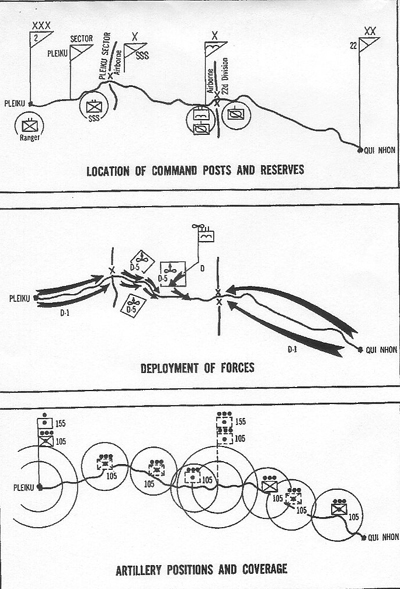
After sowing confusion among the enemy troops with the above-mentioned simultaneous significant operations, Colonel Hieu "press the Viet Cong from three directions with movements launched from Pleiku and Qui Nhon and a vertical envelopment from north of An Khe. These maneuvers were executed by a task force of the Pleiku sector departing from Pleiku, two task forces of the 22d Infantry Division departing from Qui Nhon, and a task force of two airborne battalions heliborne into northern An Khe and attacking south with Task Force Alpha of the marines brigade conducting the linkup," and "position strong reserves composed of three battalions (one ranger, one marine, and one airborne) and two armored troops at tactical points: Pleiku, Soui Doi, An Khe, and Mang Pass." All these actions resulted in the free flow of cargo convoys during 5 days from D+3 to D+7, "allowing an initial buildup of 5,365 tons of supplies in Pleiku." Afterward, operational units withdrew to their camps during D+8 and D+9.
As a result of Operation Than Phong, "the convoys transfused new life into the Highlands. Along with an immediate drop of 25 to 30 percent in the price of food and commodities, the population regained their feelings of security, confidence, and hope. School-boys in Pleiku voluntarily helped the troops in unloading the cargoes, and people who had started to evacuate now returned to their homesteads."
After the unsuccessful attempt to overcome the Special Force camp of Duc Co in August 1965, General Vo Nguyen Giap launched the Winter-Spring Campaign aiming at slicing South Vietnam into two pieces, from Pleiku in the Highlands to Qui Nhon in the coastal regions. The plan of General Chu Huy Man, VC Field Commander was as following: 1.33th Regiments NVA feigns to attack camp Pleime to entice II Corps to dispatch relief column
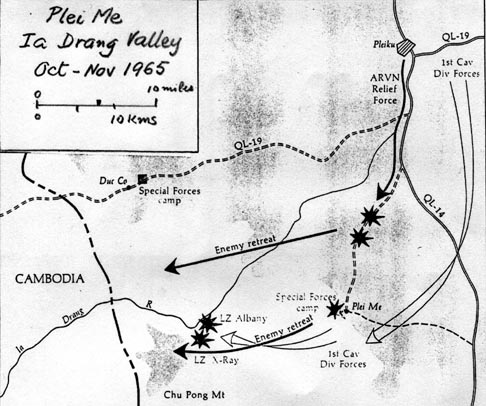 from Pleiku; 2. 32nd Regiment NVA sets an ambush to destroy the relief column (an easy target without artillery support nearby); 3. after destroying the relief column, 32nd Regiment NVA joins force with 33rd Regiment NVA in overcoming camp Pleime; 4. in the meantime, with the defense of Pleiku weakened by the troops sent out to rescue camp Pleime, 66th Regiment NVA initiates a preliminary attack against II Corps HQ, awaiting 32nd and 33rd Regiments NVA to overcome camp Pleime and to join forces to attack and occupy Pleiku.
from Pleiku; 2. 32nd Regiment NVA sets an ambush to destroy the relief column (an easy target without artillery support nearby); 3. after destroying the relief column, 32nd Regiment NVA joins force with 33rd Regiment NVA in overcoming camp Pleime; 4. in the meantime, with the defense of Pleiku weakened by the troops sent out to rescue camp Pleime, 66th Regiment NVA initiates a preliminary attack against II Corps HQ, awaiting 32nd and 33rd Regiments NVA to overcome camp Pleime and to join forces to attack and occupy Pleiku.
To counter General Chu Huy Manís smart moves, Colonel Hieu, II Corps Chief of Staff consulted with US 1st Cavalry Division and came up with the following plan: 1. II Corps feigns biting the bait by reinforcing camp Pleime with a unit of US Delta Force and a unit of ARVN Airborne Rangers; 2. and dispatches a task force from Pleiku to rescue camp Pleime; 3. US 1st Cavalry Division lends a brigade to reinforce the defense of Pleiku; 4. and heli-lifts artillery batteries to several locations near the ambush site to support the relief column when under attack.
This plan neutralized the 66th Regiment NVA, which remained inactive in the Chu Prong area, destroyed the 33rd Regiment NVA at the ambush site, and the 32nd Regiment NVA had abandoned the siege of camp Pleime and withdrew dejected into the surrounding jungles.
In June 1966, General Vinh Loc appointed Colonel Hieu 22nd Infantry Division Commander. In February 1967, Colonel Hieu launched Operation Dai Bang 800. Three days before to Vietnamese operation, units of the US 1st Cavalry Division were unsuccessful in discovering the enemy in their operational areas. Instead of searching for the enemy, Colonel Hieu was smarter in resorting to luring the enemy, by dispatching a reduced regiment to set up an overnight camp in the region of Phu My, knowing for certain that enemy spies inserted among the indigenous farmers would report the status of the operational troops. Meanwhile, Colonel Hieu positioned a motorized infantry battalion and an armored unit 10 kilometers away, out of enemies' screen radar. Thinking they had an easy target, the enemy attacked the camp with a regiment belonging to the 3rd Division NVA at 2:00 am. Alerted by the regimentís commander, Colonel Hieu sent in the reserved forces to cut the retreat route of the enemy and to join force with the defenders in an anvil-hammer tactic to destroy them. After a three-hour fierce battle, the enemy broke up contact with more than 300 deads and numerous weapons scattered all over the battleground.
In August 1969, General Hieu was given the command of the 5th Infantry Division by General Tri. At the end of 1970, General Hieu proposed to General Tri the plan of luring the enemy with a regiment placed in Snoul deep in Cambodian territory, north of Loc Ninh on National Route 13. The Communists had 3 Divisions (5th, 7th, and 9th) operating in  that area. III Corps was ready to commit all of its 3 Division (5th, 18th ,and 25th) in case the Communists dared to engage one, two or all three divisions into the battlefield. Unfortunately, General Tri died unexpectedly in a helicopter accident at the end of February 1971, and General Minh, who replaced General Tri, did not want to follow through with the luring plan when 8th Task Force was succeeding in attracting the enemy who gathered two Divisions (5th and 7th) around Snoul. The beleaguered troops of the 8th Task Force, when neither rescue column nor B-52 bombers were in sight, were about to raise the white flag to surrender to the enemy. However, General Hieu executed in time his withdrawal plan to bring back his troops to Loc Ninh. The troopís withdrawal was executed in three phases: (1) on 5/29/1971, 1/8th Battalion pierced through enemy blocking line at the northern outpost to rejoin the 8th Task Force Command Post located at Snoul market; (2) on 5/30/1971, 8th Task Force using 1/8th Battalion as the spear-head to pierce enemy blocking line, followed behind by 2/8th Battalion, Task Force Command Post, 1st Armored Squadron with 2/7th Battalion acting as rear cover, to withdraw from Snoul to the location defended by 3/8th Battalion, 3 kilometers Southeast of Snoul on National Route 13; (3) on 5/31/1971, 3/8th Battalion replaced 1/8th Battalion as the spear-head in piercing enemy blocking line, followed by 3/9th Battalion, 2/7th Battalion, Task Force Command Post, 1st Armored Squadron with 1/8th Battalion acting as rear cover, allowing 8th Task Force to reach the border on a 3 kilometer stretch and to return to Loc Ninh.
that area. III Corps was ready to commit all of its 3 Division (5th, 18th ,and 25th) in case the Communists dared to engage one, two or all three divisions into the battlefield. Unfortunately, General Tri died unexpectedly in a helicopter accident at the end of February 1971, and General Minh, who replaced General Tri, did not want to follow through with the luring plan when 8th Task Force was succeeding in attracting the enemy who gathered two Divisions (5th and 7th) around Snoul. The beleaguered troops of the 8th Task Force, when neither rescue column nor B-52 bombers were in sight, were about to raise the white flag to surrender to the enemy. However, General Hieu executed in time his withdrawal plan to bring back his troops to Loc Ninh. The troopís withdrawal was executed in three phases: (1) on 5/29/1971, 1/8th Battalion pierced through enemy blocking line at the northern outpost to rejoin the 8th Task Force Command Post located at Snoul market; (2) on 5/30/1971, 8th Task Force using 1/8th Battalion as the spear-head to pierce enemy blocking line, followed behind by 2/8th Battalion, Task Force Command Post, 1st Armored Squadron with 2/7th Battalion acting as rear cover, to withdraw from Snoul to the location defended by 3/8th Battalion, 3 kilometers Southeast of Snoul on National Route 13; (3) on 5/31/1971, 3/8th Battalion replaced 1/8th Battalion as the spear-head in piercing enemy blocking line, followed by 3/9th Battalion, 2/7th Battalion, Task Force Command Post, 1st Armored Squadron with 1/8th Battalion acting as rear cover, allowing 8th Task Force to reach the border on a 3 kilometer stretch and to return to Loc Ninh.
Was there a better-executed troop withdrawal in the entire military annal of the ARVN?
In 1974, as Deputy Commander of Operations/III Corps, assistant to General Pham Quoc Thuan, General Hieu applied Blitzkrieg (lightning war) tactic to alleviate the pressure exerted by 5th Division NVA originating from Svay Rieng Province in the Parrotís Beak area inside Kampuchea territory aiming at base camp Duc Hue. Firstly, General Hieu employed twenty mobile battalions to surround the Parrotís Beak area. Secondly, on April 27, he launched 49th Infantry Regiment and 7th Ranger Group through the swamplands around Duc Hue toward the Kampuchean border and had VNAF airplanes attack positions of 5th Division NVA units. In the meantime, he relied on two Regional Force battalions belonging to IV Corps to move from Moc Hoa up north to establish blocking positions on the southwestern edge of the 5th Division NVAís logistical base and assembly area.
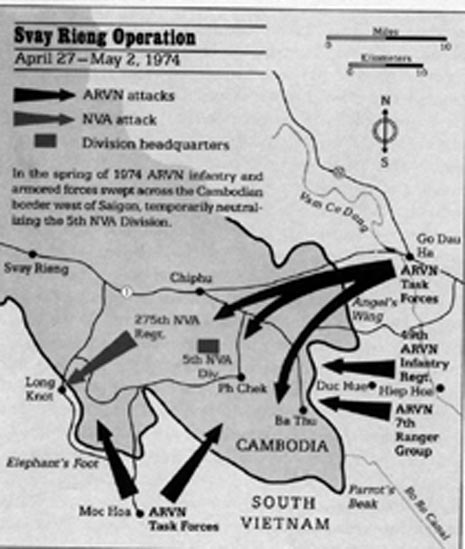
On April 28, General Hieu launched eleven battalions into the battleground to conduct a preliminary operation in preparation for the main offensive.
On the morning of April 29, three armored squadrons of the III Corps Assault Task Force rushed across the Kampuchean border from west Go Dau Ha, aiming directly at 5th Division NVA HQ.
Meanwhile, a task force composing of infantry and armor of IV Corps, originating from Moc Hoa, maneuvered across the Kampuchean border into Elephantís Foot area to threaten the retreat of 275th Regiment NVA. The three armored squadrons continued their three-pronged advance 16 kilometers deep into the Kampuchean territory before they veered south toward Hau Nghia Province, and helicopters debarked troops unexpectedly on enemy positions, while other ARVN units conducted rapid operations into the region between Duc Hue and Go Dau Ha.
On May 10, when the last ARVN units returned to their base camp, enemy communications and supplies networks were seriously disrupted. The Communists suffered 1,200 deads, 65 prisoners, and tons of weapons captured; while, due to speed, secrecy and coordination factors of a multi-faced operation, the ARVN only suffered less than 100 casualties.
This Svay Rieng battle was the last successful great battle conducted by the ARVN before the loss of the country with the concert and simultaneous participation of units equivalent to three divisions belonging to III and IV Corps.
Among the 6 above-mentioned battles, except Dai Bang 800 and Snoul, credits of the battle were attributed to other generals: Do Xa to Do Cao Tri; Than Phong and Pleime to Vinh Loc; and Svay Rieng to Pham Quoc Thuan.
Conclusion
General Hoang Xuan Lam wrote in his letter dated 03/01/1999: "We, class of Tran Hung Dao, are very proud of having a friend as loyal and as self-confident as Major General Nguyen Van Hieu."
And General Lu Lan wrote in his letter dated 09/01/1999: "A few years ago, Colonel Trinh Tieu, Chief of 2nd Corps G2 Intelligence, had written, prior to his death, a few articles pertaining to his service in the ARVN, in which he mentioned Major General Nguyen Van Hieu, with an absolute love and respect toward a Commander who was gallant, honest and most revered."
Nguyen Van Tin
December 12, 2004